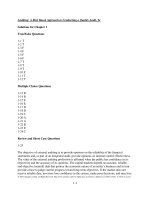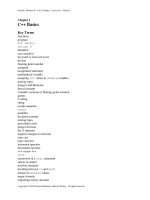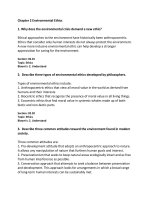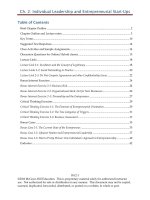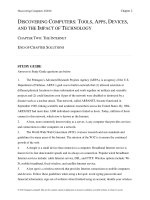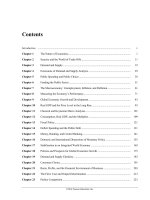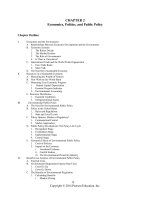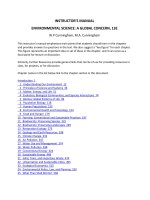Test bank and solution manual of analyzing transaction the accounting equation (2)
Bạn đang xem bản rút gọn của tài liệu. Xem và tải ngay bản đầy đủ của tài liệu tại đây (4.09 MB, 214 trang )
SM.pdf
Chapter_02_H&P_22e.pdf
Heintz, 22e_Ch02_IRM.pdf
Heintz22e_Ch02_SM_Final.pdf
Heintz22e_Comp Prob 1_SM Part 1_Final.pdf
Chapter 2
Analyzing Transactions: The Accounting Equation
CHAPTER 2
REVIEW QUESTIONS
1.
2.
3.
4.
5.
6.
7.
8.
9.
10.
accounting equation
business entity
asset
liability
account payable
owner’s equity
business entity
Owner’s Equity
Liabilities
Owner’s Equity
11.
12.
13.
14.
15.
16.
17.
18.
19.
expense
net income
net loss
fiscal year
drawing
income statement
statement of owner’s equity
balance sheet
liquidity
EXERCISES
Exercise 1
(a)
$24,000
(b)
$17,000
(c)
$40,000
Exercise 2
(a)
$90,000
(c)
$60,000
(e)
$50,000
(b)
$35,000
(d)
$55,000
(f)
$10,000
(b)
$2,880 net income
Exercise 3
Net income = $7,000
Exercise 4
Owner’s equity = $13,120
Exercise 5
(a)
$16,000
© 2017 Cengage Learning. All Rights Reserved. May not be scanned, copied or duplicated, or posted to a publicly accessible website, in whole or in part.
3
4
Chapter 2
Exercise 6
ASSETS
(a)
Bal.
(b)
15,000
15,000
(4,000)
4,000
15,000
9,000
24,000
(2,000)
22,000
Bal.
(c)
Bal.
(d)
Bal.
=
LIABILITIES
OWNER’S
EQUITY
+
15,000
15,000
15,000
9,000
9,000
(2,000)
7,000
=
15,000
+
15,000
Exercise 7
ASSETS
= LIABILITIES +
(Items Owned) (Amts. Owed)
OWNER’S EQUITY
(Owner’s Investment)
(Earnings)
Cash
Accounts
Payable
Bal.
28,000
8,000
(a)
4,000
(b)
(1,200)
1,200
(c)
(200)
200
(d)
(600)
Bal.
Glen Ross,
Glen Ross,
Capital
– Drawing +
Revenues
–
Expenses
Description
20,000
4,000
Service Fees
Rent Exp.
Utilities Exp.
600
30,000
=
30,000
=
8,000
+
20,000
−
600
+
4,000
−
1,400
30,000
© 2017 Cengage Learning. All Rights Reserved. May not be scanned, copied or duplicated, or posted to a publicly accessible website, in whole or in part.
Chapter 2
Analyzing Transactions: The Accounting Equation
5
Exercise 8
1.
ASSETS
(Items Owned)
= LIABILITIES +
OWNER’S EQUITY
(Amts. Owed)
(Owner’s Investment)
(Earnings)
(a)
Office
Accounts
Cash + Equipment = Payable
10,000
(b)
5,500
(c)
J. Moore, J. Moore,
+ Capital – Drawing + Revenues – Expenses
10,000
5,500
900
(d)
(6,000)
(e)
1,500
900
Service Fees
1,500
Service Fees
6,000
(f)
(800)
800
(g)
(75)
75
(h)
(100)
(i)
(500)
Bal.
4,925 +
16,425
Description
Rent Exp.
Phone. Exp.
(100)
500
11,500 =
5,400
+ 10,000 −
=
500
+
2,400
−
875
16,425
2.
Total assets.................................................................
$ 16,425
Total liabilities...........................................................
$ 5,400
Owner’s equity...........................................................
$ 11,025
Owner’s equity in excess of original investment.......
$ 1,025
Total revenues............................................................
$ 2,400
Total expenses............................................................
$
Net income.................................................................
$ 1,525
875
© 2017 Cengage Learning. All Rights Reserved. May not be scanned, copied or duplicated, or posted to a publicly accessible website, in whole or in part.
6
Chapter 2
Exercise 9
Judith Moore Enterprises
Income Statement
For Month Ended July 31, 20-Revenue:
Service fees
$2,400
Expenses:
Rent expense
$800
Phone expense
75
Total expenses
875
Net income
$1,525
Exercise 10
Judith Moore Enterprises
Statement of Owner’s Equity
For Month Ended July 31, 20-Judith Moore, capital, July 1, 20--
$10,000
Investment in July
10,000
Total investment
Net income for July
Less withdrawals for July
Increase in capital
Judith Moore, capital, July 31, 20--
$10,000
$1,525
500
1,025
$11,025
© 2017 Cengage Learning. All Rights Reserved. May not be scanned, copied or duplicated, or posted to a publicly accessible website, in whole or in part.
Chapter 2
Analyzing Transactions: The Accounting Equation
Exercise 11
Judith Moore Enterprises
Balance Sheet
July 31, 20-ASSETS
Cash
Office equipment
LIABILITIES
$ 4,925
Accounts payable
$ 5,400
11,500
OWNER’S EQUITY
Judith Moore, capital
Total assets
$16,425
Total liabilities and owner’s equity
11,025
$16,425
© 2017 Cengage Learning. All Rights Reserved. May not be scanned, copied or duplicated, or posted to a publicly accessible website, in whole or in part.
7
8
Chapter 2
PROBLEMS
Problem 12
ASSETS
1.
2.
3.
4.
=
LIABILITIES
$18,800
$23,400
$21,900
Net income for January = $2,100
Net loss for February = $300
+
OWNER’S EQUITY
$4,700
$7,200
$6,000
$14,100
$16,200
$15,900
Problem 13
1.
ASSETS
= LIABILITIES +
(Amts.
Owed)
(Items Owned)
Cash
(a)
+
Office
Equip.
(Owner’s Investment)
(Earnings)
Prepaid
Accounts
J. Moore, J. Moore,
+ Insur. = Payable + Capital – Drawing + Revenues – Expenses
12,000
(b)
OWNER’S EQUITY
Description
12,000
7,500
7,500
(c)
(800)
(d)
700
(e)
(600)
600
Rent Exp.
(f)
(150)
150
Wages Exp.
(g)
(200)
(h)
(3,000)
(i)
(100)
Bal.
7,850 +
800
700
Cons. Fees
200
(3,000)
100
8,300 +
16,350
200
=
=
4,500
+ 12,000
–
100
+
700
–
750
16,350
© 2017 Cengage Learning. All Rights Reserved. May not be scanned, copied or duplicated, or posted to a publicly accessible website, in whole or in part.
Chapter 2
Analyzing Transactions: The Accounting Equation
Problem 13 (Concluded)
2.
Total assets .....................................................................................
Total liabilities ...............................................................................
Owner’s equity ...............................................................................
Change in owner’s equity from original investment ......................
Total revenues ................................................................................
Total expenses ................................................................................
Net income (loss) ...........................................................................
$ 16,350
$ 4,500
$ 11,850
$ (150)
$
700
$
750
$
(50)
Problem 14
Susan Cole Consulting Services
Income Statement
For Month Ended October 31, 20—
Revenue:
Consulting fees
$700)
Expenses:
Rent expense
Wages expense
Total expenses
Net income (loss)
$600
150
750)
$ (50)
© 2017 Cengage Learning. All Rights Reserved. May not be scanned, copied or duplicated, or posted to a publicly accessible website, in whole or in part.
9
10
Chapter 2
Problem 15
Susan Cole Consulting Services
Statement of Owner’s Equity
For Month Ended October 31, 20-Susan Cole, capital, October 1, 20--
$12,000)
Investment in October
12,000)
Total investment
$12,000)
Less: Net loss for October
$ 50
Withdrawals for October
100
Decrease in capital
(150)
Susan Cole, capital, October 31, 20--
$11,850)
Problem 16
Susan Cole Consulting Services
Balance Sheet
October 31, 20-ASSETS
Cash
Prepaid insurance
Office equipment
LIABILITIES
$ 7,850
Accounts payable
200
8,300
OWNER’S EQUITY
Susan Cole, capital
Total assets
$ 4,500
$16,350
Total liabilities and owner’s equity
11,850
$16,350
© 2017 Cengage Learning. All Rights Reserved. May not be scanned, copied or duplicated, or posted to a publicly accessible website, in whole or in part.
Chapter 2
Analyzing Transactions: The Accounting Equation
11
Problem 17
1.
Cash
(a)
ASSETS
= LIABILITIES +
(Items Owned)
(Amts.
Owed)
(Owner’s Investment)
(Earnings)
Accounts
Office
Accounts
S. Cassady, S. Cassady,
+ Receivable. + Supplies = Payable + Capital – Drawing + Revenues – Expenses
10,000
(200)
200
(c)
(400)
800
(d)
300
(e)
(600)
(f)
(100)
(g)
200
(h)
(200)
(i)
200
9,200 +
Description
10,000
(b)
Bal.
OWNER’S EQUITY
400
300
Typing Fees
600
Rent Exp.
100
400
600
Typing Fees
(200)
(200)
200
10,400
+ 1,000
=
=
200
+ 10,000 –
100
+
900
–
600
10,400
© 2017 Cengage Learning. All Rights Reserved. May not be scanned, copied or duplicated, or posted to a publicly accessible website, in whole or in part.
12
Chapter 2
Problem 17 (Concluded)
2.
Stuart Cassady Typing Service
Income Statement
For Month Ended April 30, 20-Revenue:
Typing fees
$900
Expense:
Rent expense
600
Net income
$300
Stuart Cassady Typing Service
Statement of Owner’s Equity
For Month Ended April 30, 20-Stuart Cassady, capital, April 1, 20--
$10,000
Investment in April
10,000
Total investment
$10,000
Net income for April
$300
Less withdrawals for April
100
Increase in owner’s equity
200
Stuart Cassady, capital, April 30, 20--
$10,200
Stuart Cassady Typing Service
Balance Sheet
April 30, 20-ASSETS
Cash
Accounts receivable
Office supplies
LIABILITIES
$ 9,200
Accounts payable
200
200
1,000
OWNER’S EQUITY
Stuart Cassady, capital
Total assets
$
$10,400
Total liabilities and owner’s equity
10,200
$10,400
© 2017 Cengage Learning. All Rights Reserved. May not be scanned, copied or duplicated, or posted to a publicly accessible website, in whole or in part.
© 2017 Cengage Learning®. May not be scanned, copied or duplicated, or posted to a publicly accessible website, in whole or in part, except for use as permitted in a license distributed with a
certain product or service or otherwise on a password-protected website or school-approved learning management system for classroom use.
Chapter
2
Analyzing
Transactions:
The Accounting
Equation
©©2017
Cengage Learning.
Learning®.
notReserved.
be scanned,
duplicated,
or posted
to a publicly
accessible
website,
in whole
in permitted
part, except
use asdistributed
permitted with
in a license
distributed
with
a
2014Cengage
AllMay
Rights
Maycopied
not beorcopied,
scanned,
or duplicated,
in whole
or in part,
except
for useoras
in aforlicense
a certain
product or
service
or
certain
product
service or otherwise
on a password-protected
otherwise
on a or
password-protected
website
for classroom use. website or school-approved learning management system for classroom use.
Learning
Objective
1
Define the accounting
elements.
© 2014Cengage
Learning.
All Rights
May notcopied
be copied,
scanned,or
orposted
duplicated,
in wholeaccessible
or in part,website,
except for
use asor
permitted
in a license
distributed
withina a
© 2017 Cengage
Learning®.
MayReserved.
not be scanned,
or duplicated,
to a publicly
in whole
in part, except
for use
as permitted
certain
product
or service
otherwise
on a or
password-protected
website
for classroom use. website or school-approved learning management system for classroom use.
license
distributed
withor
a certain
product
service or otherwise
on a password-protected
Business Entity
An individual, association, or
organization that engages in economic
activities and controls specific
economic resources
The business entity’s finances are kept
separate from the owner’s
nonbusiness assets and liabilities
(business entity concept)
© 2017 Cengage Learning®. May not be scanned, copied or duplicated, or posted to a publicly accessible website, in whole or in part, except for use as
in a license
distributed
with
a certainMay
product
or copied,
service scanned,
or otherwise
on a password-protected
website
or school-approved
learning
©permitted
2014Cengage
Learning.
All Rights
Reserved.
not be
or duplicated,
in whole or in part,
except
for use as permitted
in a management
license
system forwith
classroom
use.
distributed
a certain
product or service or otherwise on a password-protected website for classroom use.
Assets
Items owned by a business that will
provide future benefits.
MUST BE “OWNED”
NOT RENTED
© 2017 Cengage Learning®. May not be scanned, copied or duplicated, or posted to a publicly accessible website, in whole or in part, except for use as
in a license
distributed
with
a certainMay
product
or copied,
service scanned,
or otherwise
on a password-protected
website
or school-approved
learning
©permitted
2014Cengage
Learning.
All Rights
Reserved.
not be
or duplicated,
in whole or in part,
except
for use as permitted
in a management
license
system forwith
classroom
use.
distributed
a certain
product or service or otherwise on a password-protected website for classroom use.
Assets (cont.)
Items owned by a business that will
provide future benefits.
BUT DOESN’T HAVE TO BE PAID
OFF, COULD STILL BE MAKING
PAYMENTS ON IT
© 2017 Cengage Learning®. May not be scanned, copied or duplicated, or posted to a publicly accessible website, in whole or in part, except for use as
in a license
distributed
with
a certainMay
product
or copied,
service scanned,
or otherwise
on a password-protected
website
or school-approved
learning
©permitted
2014Cengage
Learning.
All Rights
Reserved.
not be
or duplicated,
in whole or in part,
except
for use as permitted
in a management
license
system forwith
classroom
use.
distributed
a certain
product or service or otherwise on a password-protected website for classroom use.
Assets (cont.)
Examples:
Cash
Merchandise
Furniture
Fixtures
Machinery
Buildings
Land
Accounts Receivable
© 2017 Cengage Learning®. May not be scanned, copied or duplicated, or posted to a publicly accessible website, in whole or in part, except for use as
in a license
distributed
with
a certainMay
product
or copied,
service scanned,
or otherwise
on a password-protected
website
or school-approved
learning
©permitted
2014Cengage
Learning.
All Rights
Reserved.
not be
or duplicated,
in whole or in part,
except
for use as permitted
in a management
license
system forwith
classroom
use.
distributed
a certain
product or service or otherwise on a password-protected website for classroom use.
Accounts Receivable
The amount of money owed to the
business by its customers as a result of
making sales “on account” or “on
credit”
Simply put, the customers have
promised to pay sometime in the
future.
© 2017 Cengage Learning®. May not be scanned, copied or duplicated, or posted to a publicly accessible website, in whole or in part, except for use as
in a license
distributed
with
a certainMay
product
or copied,
service scanned,
or otherwise
on a password-protected
website
or school-approved
learning
©permitted
2014Cengage
Learning.
All Rights
Reserved.
not be
or duplicated,
in whole or in part,
except
for use as permitted
in a management
license
system forwith
classroom
use.
distributed
a certain
product or service or otherwise on a password-protected website for classroom use.
Liabilities
Something owed to another business
entity
A probable future outflow of assets as
a result of a past transaction or event.
IN OTHER WORDS, DEBTS OR
OBLIGATIONS OF THE BUSINESS
THAT CAN BE PAID WITH CASH,
GOODS, OR SERVICES.
© 2017 Cengage Learning®. May not be scanned, copied or duplicated, or posted to a publicly accessible website, in whole or in part, except for use as
in a license
distributed
with
a certainMay
product
or copied,
service scanned,
or otherwise
on a password-protected
website
or school-approved
learning
©permitted
2014Cengage
Learning.
All Rights
Reserved.
not be
or duplicated,
in whole or in part,
except
for use as permitted
in a management
license
system forwith
classroom
use.
distributed
a certain
product or service or otherwise on a password-protected website for classroom use.
Liabilities (cont.)
Examples:
Accounts Payable
Notes Payable
© 2017 Cengage Learning®. May not be scanned, copied or duplicated, or posted to a publicly accessible website, in whole or in part, except for use as
in a license
distributed
with
a certainMay
product
or copied,
service scanned,
or otherwise
on a password-protected
website
or school-approved
learning
©permitted
2014Cengage
Learning.
All Rights
Reserved.
not be
or duplicated,
in whole or in part,
except
for use as permitted
in a management
license
system forwith
classroom
use.
distributed
a certain
product or service or otherwise on a password-protected website for classroom use.
Accounts Payable
An unwritten promise to pay a supplier
for assets purchased or services
received
Referred to as making a purchase “on
account” or “on credit”
Be careful!! Don’t confuse accounts
receivable and accounts payable. Ask
yourself: Are we waiting to receive?
Or waiting to pay?
© 2017 Cengage Learning®. May not be scanned, copied or duplicated, or posted to a publicly accessible website, in whole or in part, except for use as
in a license
distributed
with
a certainMay
product
or copied,
service scanned,
or otherwise
on a password-protected
website
or school-approved
learning
©permitted
2014Cengage
Learning.
All Rights
Reserved.
not be
or duplicated,
in whole or in part,
except
for use as permitted
in a management
license
system forwith
classroom
use.
distributed
a certain
product or service or otherwise on a password-protected website for classroom use.
Notes Payable
Formal written promises to pay
suppliers or lenders specified sums of
money at definite future times
© 2017 Cengage Learning®. May not be scanned, copied or duplicated, or posted to a publicly accessible website, in whole or in part, except for use as
in a license
distributed
with
a certainMay
product
or copied,
service scanned,
or otherwise
on a password-protected
website
or school-approved
learning
©permitted
2014Cengage
Learning.
All Rights
Reserved.
not be
or duplicated,
in whole or in part,
except
for use as permitted
in a management
license
system forwith
classroom
use.
distributed
a certain
product or service or otherwise on a password-protected website for classroom use.
Owner’s Equity
Amount by which the business assets
exceed the business liabilities.
Also called:
NET WORTH
OR
CAPITAL
© 2017 Cengage Learning®. May not be scanned, copied or duplicated, or posted to a publicly accessible website, in whole or in part, except for use as
in a license
distributed
with
a certainMay
product
or copied,
service scanned,
or otherwise
on a password-protected
website
or school-approved
learning
©permitted
2014Cengage
Learning.
All Rights
Reserved.
not be
or duplicated,
in whole or in part,
except
for use as permitted
in a management
license
system forwith
classroom
use.
distributed
a certain
product or service or otherwise on a password-protected website for classroom use.
Business Entity Concept
The owner of a business may have
business assets and liabilities as well as
nonbusiness assets and liabilities.
Nonbusiness assets and liabilities are
not included in the business entity’s
accounting records.
If the owner invests money or other
assets in the business, the investment
is now reclassified as a business asset.
© 2017 Cengage Learning®. May not be scanned, copied or duplicated, or posted to a publicly accessible website, in whole or in part, except for use as
in a license
distributed
with
a certainMay
product
or copied,
service scanned,
or otherwise
on a password-protected
website
or school-approved
learning
©permitted
2014Cengage
Learning.
All Rights
Reserved.
not be
or duplicated,
in whole or in part,
except
for use as permitted
in a management
license
system forwith
classroom
use.
distributed
a certain
product or service or otherwise on a password-protected website for classroom use.
